about the writer
David Maddox
David loves urban spaces and nature. He loves creativity and collaboration. He loves theatre and music. In his life and work he has practiced in all of these as, in various moments, a scientist, a climate change researcher, a land steward, an ecological practitioner, composer, a playwright, a musician, an actor, and a theatre director. David’s dad told him once that he needed a back up plan, something to “fall back on”. So he bought a tuba.
Introduction
Do we truly believe in the benefits of ecosystem services? If we do, then two important questions emerge. First, who should enjoy these benefits? The answer should be self-evident: everyone. Second, do city residents around the world currently enjoy these benefits? In short, and emphatically: no. If we believe in nature-based solutions to urban challenges, from sustainability to livability, then we must also believe in the fair and equitable access to such solutions. All green infrastructure designs and their implementations inherently include decisions about justice and equity, which means that access to “green” is an issue of justice. And, solutions are available, one would think.
Traditionally, environmental justice discussions have focused on the geographic distribution of environmental risks—the observation that poor communities disproportionately bear the burden of pollution from the systems that sustain affluent lifestyles elsewhere. This issue isn’t solved. The poor and politically unconnected around the world continue to experience greater levels of pollution and other environmental risks.
There is a flip side to the environmental justice equation: do people have equal access to the benefits of ecosystem services? We are lagging here, also—evidence shows that not everyone has equitable access to the health, happiness, and other social benefits that are the well documented results of parks, street trees, and open space. Poorer neighborhoods throughout the world tend to have less access to parks and other green elements. Nor does everyone have equal access to the nature-based solutions that can provide resilience to storms, floods, and other disturbances.
Even when green infrastructure—e.g., parks large and small, natural areas, water fronts, street trees—is incorporated into the design of neighborhoods underserved by open spaces or other green elements—which are typically the less affluent ones—there can be unintended results. First, planners often impose green design elements onto communities without fully consulting community members about what they want and need. Such a lack of inclusive decision-making can produce green spaces that are ill-suited for the neighborhood. The second driver of unexpected, negative outcomes from green design is what we might broadly call “gentrification” and its outcomes. During gentrification, as green infrastructure appears in neighborhoods, the neighborhoods may become more desirable to people living in other places. Rents and housing values rise, and many residents can no longer afford to live there; instead, they are displaced, priced out of their newly improved neighborhoods.
We have written about these issues before at TNOC, including the 2015 roundtable What are the social justice implications of urban ecology?, and the 2015 book The Just City Essays.
What is the answer to this challenge? If the benefits of nature-based solutions to urban problems are real, then improving all neighborhoods with green infrastructure must be key to the creation of cities that are more resilient, sustainable, livable, and just for everyone. Is it just about building more green infrastructure and building smarter? Being clear about “ecosystems for whom?” Or perhaps something more radical is needed—a fundamental reinvention of how we construct our economies and cities?
So, the challenge is ecosystems for everyone. How close are we to this moral imperative and how will we achieve it? Here are 18 responses exploring these critical questions.
about the writer
Diana Wiesner
Diana Wiesner is a landscape architect, proprietor of the firm Architecture and Landscape, and director of the non-profit foundation Cerros de Bogotá.
Diana Wiesner
Ecological services in a given place must be concerned with more than just the issue of nature itself: it must be remembered that these services are also loaded with meanings and memories that represent the soul of the community.
In pondering the question: “Who should have access to the countless benefits and services that urban ecosystems provide?” We have put together a collection of six first- person accounts that portray city dwellers´ dreams.

“My name is Jorge Enrique. I grew up in the country, but I had to leave during a period of political violence. I came to Bogota with my family. I dream about Bogota´s northern border being turned into a giant forest that would unite the eastern mountain range with the plateau below so that all the falling water could flow through it. Right now, the mountain formations can´t be together, but they are winking at each other and playing hide-and-seek, because they know that someday the giant forest will make their rendezvous possible.”
“My name is Enilfa. I live in a neighborhood in the southern part of the city. Most of the houses are only half-built, and the streets are filled with dust that comes from the nearby open-air quarries. Progress means that some of the streets have been paved. The truth is that most of the people who live here don´t want to see any trees planted because they would only give the criminals with knives in their hands a place to hide behind. If the city wants to build us a park, we just want playground equipment and benches in it.”

“My name is Moses, but some people can´t pronounce it right and they call me ´Moset´. I was born on April 4, 1928, and because of the political violence in the country I was forced to move to the northern part of Bogota with my family. I dream about us building a harmonious, mutually-dependent and reciprocal relationship with the communities in the mountains and with those who live along the banks of the Cedar Brook which pours into the Torca Brook and then into the Bogota River.”

“I am the grandmother, Ichakaka Blanca. I belong to the indigenous nation of the Muiscas whose territory is called Bacata (Bogota). We lived here with my grandmother, Amalia, who was the doctor. She used traditional medicine from our territory to treat people. She applied the remedies herself. She also wove baskets and gathered all kinds of vegetables and medicinal plants to take to the October 12th Market Place where she bartered with them. It was a cultural exchange: she gave what she had brought for salt and cane sugar in return. Those are the things she would bring back home.
We need to have sacred places where we can plant our crops; what I see every day in the city are just more and more playing fields for sports being built. We need to have a beautiful place so we can live in dignity as human beings—that´s what we need the most: a place where we can go and speak to our ´Older Brother´; to our brothers and sisters, the trees; to nature; a place where we can rest.”
* * * * *
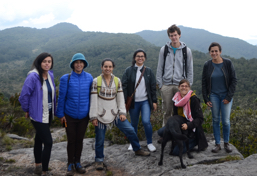
The Sketches of Life Initiative includes real life-stories as told by inhabitants from different corners of Bogota. This Initiative, carried out by Bogota Mountain Foundation volunteers, including Sandra Valencia, Johanna Gonzalez, Lina Prieto, Paula Faure, Daniela Robayo, Catalina Garcia, Benoit de Santignon, and Maria Alejandra Peña who recorded the observations, which reveal that ecological services in a given place must be concerned with more than just the issue of nature itself: it must be remembered that these services are also loaded with meanings and memories that represent the soul of the community. Therefore, plans based solely on quantitative distribution and indicators are insufficient: the soulfulness of the area´s inhabitants must also be taken into account.
In Bogota, we have a long way to go in fulfilling this moral obligation: an obligation, which demands that nature and the landscape, make up part of a more equitable city.1
For more of these stories, in English and Spanish, click here.
1Translated by Steven Bayless
about the writer
Andrew Rudd
Andrew Rudd is the Urban Environment Officer for UN-Habitat’s Urban Planning & Design Branch in New York, where he leads substantive advocacy for the urban dimension of the 2030 Agenda for Sustainable Development (including the SDGs).
Andrew Rudd
I am a pessimist, but I think that without some degree of pessimism we are less attuned to what it happening around us—unless it is happening directly to us.
In social media many protested the disproportionate focus of reporting on flooding from Hurricane Harvey in the US, where 71 died, as opposed to flooding from the monsoon in South Asia, where 1,300 did. This is worth our attention. But not as an “act of god”—rather as something within our collective power that we have so far declined to address. The countries emitting the most per capita are often not the ones at the most risk, and even those at highest risk are not necessarily always the ones experiencing the greatest destruction. In 2013 the US had a per capita greenhouse gas emission rate of at least 16 times that of Bangladesh (http://cait.wri.org/), despite facing less than one-sixth the risk of climate change induced-disaster (http://germanwatch.org/klima/cri11.pdf). Geographic location plays a part, but so does wealth: Bangladesh is already one of the poorest countries in the world, with a per capita GDP that is four percent of that of the US (https://www.indexmundi.com/g/r.aspx?v=67).
The impoverishment and vulnerability of much of Bangladesh’s population has come in large part as a result of Structural Adjustment Programs that—as elsewhere—have privatized public goods, reduced the quality and security of jobs and prompted land-grabbing and deforestation since the 1970s. Microfinance has not affected the overall trend. With very few means to evacuate—much less rebuild—the most vulnerable have little choice but to try to survive in place. In extremely population-dense countries like Bangladesh where privatization has destroyed river systems and exacerbated flooding, even internal relocation is not a realistic option. ‘[T]he dominant development paradigm…produces and reproduces poverty for many and affluence for the few, destroying nature and people’s lives’ (https://monthlyreview.org/2015/03/01/bangladesh-a-model-of-neoliberalism/).
Even in wealthier countries such as the US there is great inequality of exposure between and within cities. A number of newer cities in the “sun belt” of the US—such as Houston—have knowingly built and expanded in areas with disproportionate exposure to environmental bads (e.g. flooding, hurricanes, mosquitos) under the promethean belief that technology and optimism would trump nature. As a global petrochemical hub Houston is directly responsible for significant greenhouse gas emissions as a result of the oil and gas production process itself (https://www.foreffectivegov.org/oil-and-gas-production-major-source-of-greenhouse-gas-emissions-epa-data-reveals). And as a direct consumer of oil and gas Houston is also one of the highest per capita GHG-emitting cities in the US. Houston’s leaders have long touted its infinite room to expand and its pro-greenfield development policies have yielded low-density, energy-hungry sprawl that all but requires long commutes in private cars. With virtually no limits on impervious land cover, flood risk has increased.
Houston is increasingly coming to absorb some of the costs of these bads, though in a very uneven way. In general, around 40,000 houses were significantly damaged or destroyed, and despite the relative wealth of the region fewer than 20% of these properties were insured for flooding. Rarely did the city require it nor could the poor afford it. Still, many locals have responded with icarian stubbornness that the city will rebuild in many of the same locations. Past and current heads of the local flood control district, who are not directly accountable to Houston voters, deny the role of climate change in flooding and continue to champion engineering as a solution to the destruction and pavement of the flood-resilient prairie (https://theoutline.com/post/2202/climate-change-denial-should-be-a-crime). The city has virtually no land use zoning to ensure that toxic industries locate away from people and environmentally sensitive areas. There is only NIMBYism (“not in my backyard”) to distance them from the wealthy. And that means the refineries and chemical plants have ended up along the low-lying waterways in eastern Houston, in a corridor predominantly populated by poor Latinos (including Latino immigrants). Not only did the flooding from Hurricane Harvey stir up a noxious cocktail of carcinogens, it also prompted several hazardous explosions in the area.
The US pulling out of the Paris Agreement is going to make things even worse for the poor, particularly in less capacitated countries. There is simply too little action from those who are empowered to take action. But this isn’t necessarily due to lack of agency. Neoliberalism, which has weakened the state’s regulation of environmental bads, has also encouraged competition over cooperation, obscured responsibility and corroded the social interdependencies that once made it possible to commonly manage resources for the public good. Now transnational corporations are relocating their dirty work with increasing frequency to places with the most lax environmental and labor regulations. Unable to move, many people are simply stuck with the worst jobs that give them too few resources to live in all but the most vulnerable, polluted, and underresourced parts of the country.
I don’t see any of this changing soon.
I am a pessimist, but I think that without some degree of pessimism we are less attuned to what is happening around us—unless it is happening directly to us. We are less likely to hold elected officials accountable for the socioeconomic policies that are exacerbating inequality. And—according to some studies—we are less likely to resist pressure to harm the powerless. Without empathy for those who are far away and in the future, for the voiceless and for non-agents, as Dale Jamieson puts it (http://onlinelibrary.wiley.com/wol1/doi/10.1111/1758-5899.12113/full), there is little hope for a human future on this planet, much less an environmentally just one.
about the writer
Nadja Kabisch
Nadja Kabisch holds a PhD in Geography. Her special interest is on human-environment interactions in cities taking co-benefits from nature-based solutions implementation for human health and social justice into account.
Nadja Kabisch
We have learned that when urban planning does not include the local community properly, green development projects can fail.
As cities grow and further develop, urban planning seeks to improve environmental conditions in cities through the redevelopment of former industrial areas—so called brown fields—into new parks or green spaces. Some cities—e.g. Berlin—plan for brownfield redevelopment in deprived areas to improve the situation of less advantaged groups. What has happened earlier is that brownfield redevelopment and the creation of high quality green spaces have led to an upgrade of the particular city area or neighbourhood. Since some years, there is the fear of green gentrification in which the greening strategies would lead to higher rents for those the green development was intended to help, to the extent that they cannot afford to stay anymore. This fear is reasonable as case studies from German cities such as Berlin or Leipzig already showed. The debate on green gentrification is not new. In fact, responding to different case studies around the globe, authors—also in TNOC (2014) three years ago—discussed the potential of residential displacement kicked off by urban greening developments. Some solutions have been outlined which mainly responded to cases of the developed world. These potential solutions to counteract green gentrification mainly recalled urban planning to think together the greening development of an area with potential effects in market oriented processes and vice versa the impact on the residential population in a holistic way.
I am partly with Marcelo Lopes de Souza (2017), who pointed out in TNOC recently that these discussions were too optimistic regarding the opportunities and available instruments state-led urban planning really has. Given the way the market works in western, neo-liberal state-led urban planning may certainly reach its limits. Particularly in cities with poor financial budgets, decisions are taken that promote economic development rather than consider the socio-economic situation of residents. Still, I do have hope that the careful consideration of where to plan for urban nature taking into consideration the overall structure of the city—including land cover but simultaneously the socio-economic situation in all neighbourhoods—may lead to new forms of policy instruments that ensure that the existing population can stay, enjoy, and benefit from the green development. These instruments may go hand in hand with the involvement of local residents in all stages of a green development project.
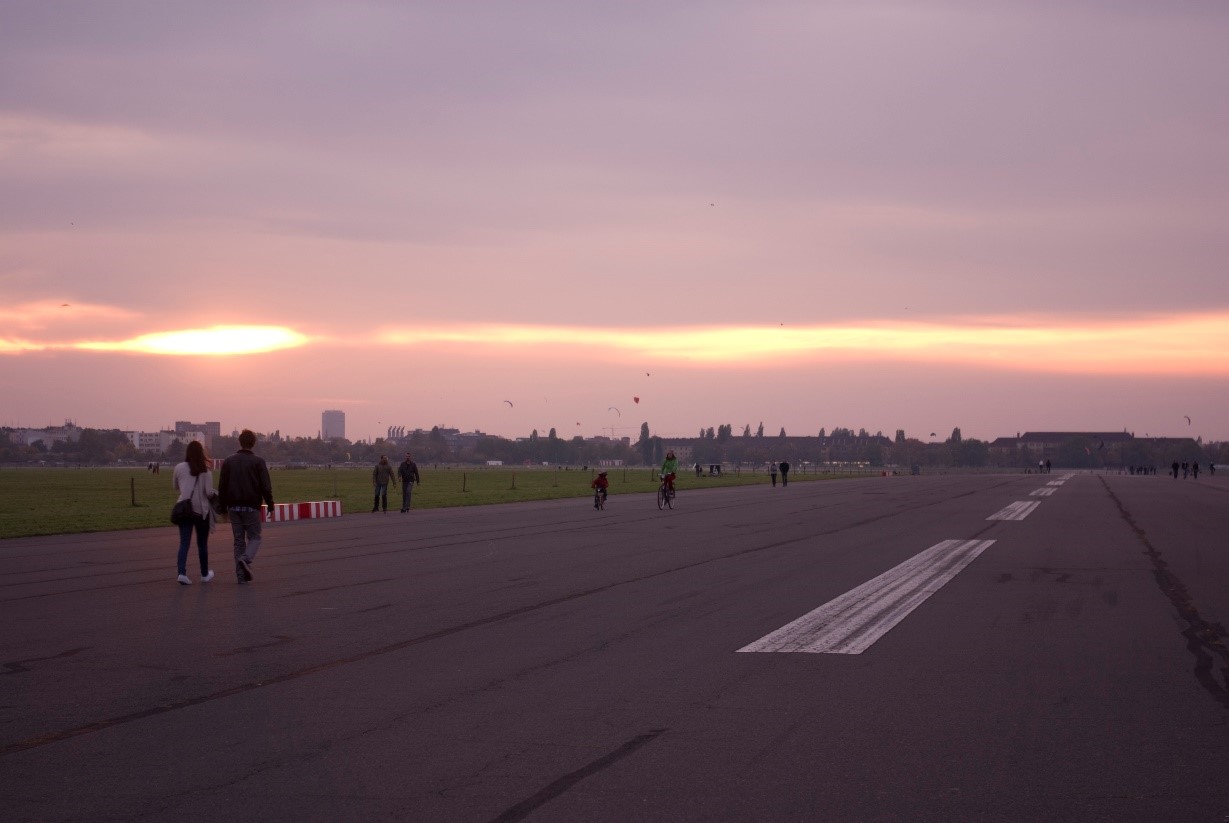
What we have learned from a popular case in Berlin is that when urban planning does not include the local community properly, green development projects can fail. The former city airport of Berlin—the Tempelhofer Feld—was supposed to be redeveloped based on a masterplan (2013) that included residential development that was obviously supposed to be high class development. Fearing the gentrification of the neighbourhoods, local communities initiated a Berlin-wide referendum in 2014 to vote in favour of keeping the area as it is and against the masterplan. The referendum succeeded. More than 46% of eligible voters participated and from those nearly 65% (nearly 740,000! people) voted in favour of the current area. The power of the local community was not anticipated by city officials but the city’s initial plans were finally stopped.
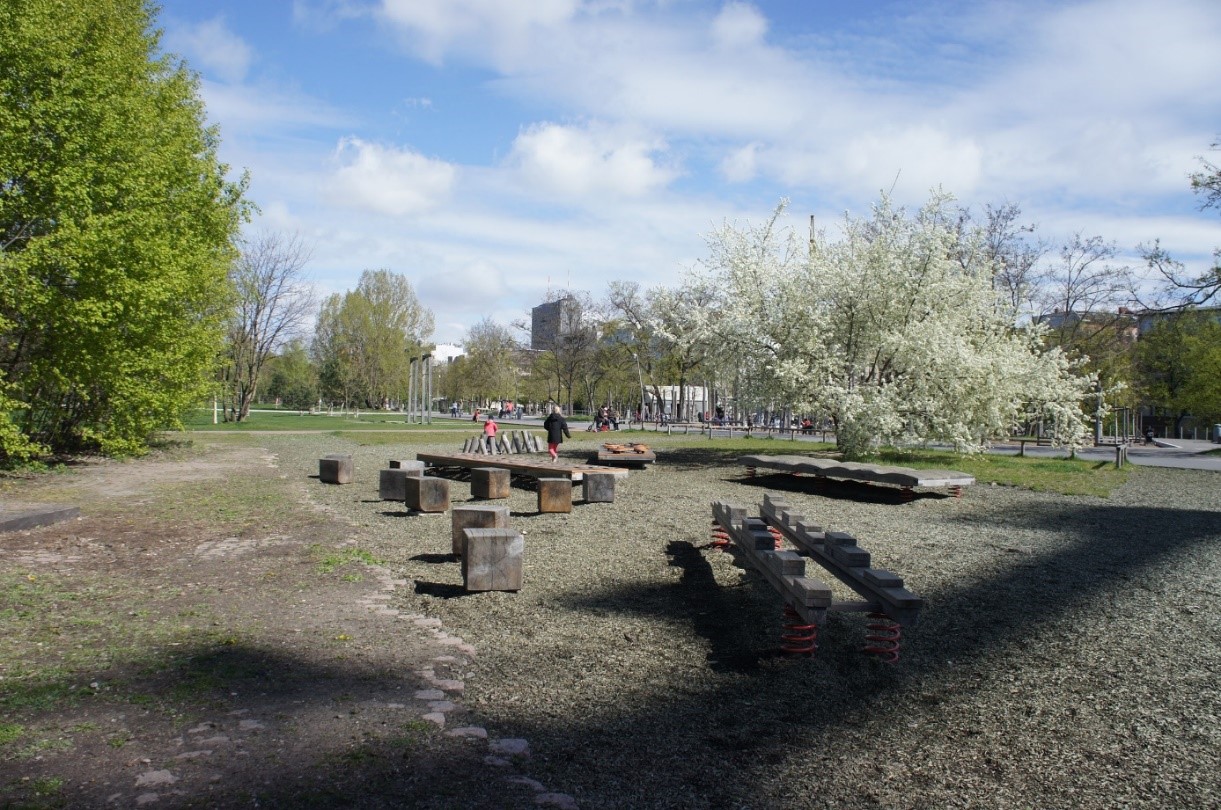
From cases like the Tempelhofer Feld in Berlin, we learn how powerful the voice of citizens can be and that more collective planning of green spaces through active involvement of citizens in urban planning and decision making is important when contributing to a more resilient and just urban environment. Setha Low, a U.S. anthropologist, highlighted the participation of all affected groups in planning and design as a way of procedural justice—an important dimension in the socio-environmental justice debate. This includes, a screening of the local neighbourhoods to identify the potential user groups that can belong to different cultures and age groups and their needs and expectations. Integrating them may promote the right decisions for design features to development and to ensure that it is used and most beneficial for those living in the area.
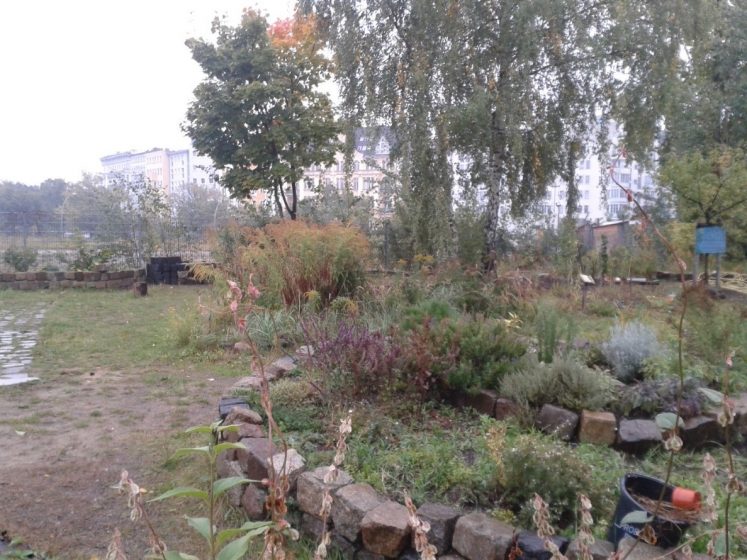
The Gleisdreieck in Berlin is a particular example where a former railway brownfield side was redeveloped into a multifunctional park. Public workshops and roundtable discussions took place to identify resident’s desires on how the area should be developed to make best use finally for all population groups. Today, the park integrates designated areas for wildlife conservation, lawns for relaxation or playing sports, large playground areas and nature experience areas for children at any age, bmx-areas and an intercultural community garden (Picture 2 to 4). As the integration of local residential groups in planning processes is already part of many development processes—at least in the developed world, we can state, that for procedural environmental justice, yes, we are a step further.
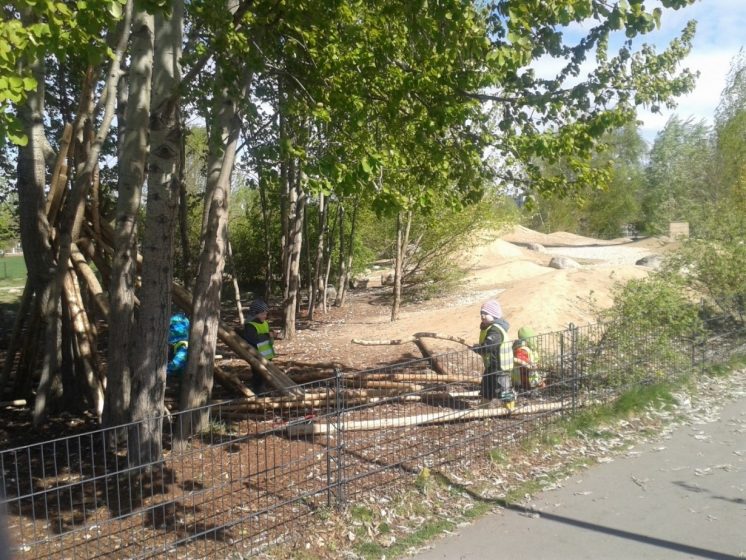
Further reading:
Kabisch, N., Haase, D. (2014) Green Justice or just Green? Urban Green Space Provision in the City of Berlin. Landscape and Urban Planning 122, 129-139.
Kabisch, N., Strohbach, M., Haase, D., Kronenberg, J. (2016) Urban Green Space Availability in European cities. Ecological Indicators. http://dx.doi.org/10.1016/j.ecolind.2016.02.029
Haase, D., Kabisch, S., Haase, A., Kabisch, N. (2017): Greening cities to be socially inclusive? About the alleged paradox of society and ecology in cities, In: Habitat International 64, 41-48. doi: 10.1016/j.habitatint.2017.04.005.
Low, S. (2013): Public space and diversity: Distributive, procedural and interactional justice for parks. In G. Young, & D. Stevenson (Eds.), The Ashgate research companion to planning and culture (pp. 295–310). Surrey: Ashgate Publishing.
Lopes de Souza, M. (2017) For the Sake of the Common Good? “Gentrifying Conservationism” and “Green Evictions”, Rio de Janeiro. 13 August 2017.
TNOC [The Nature of Cities]. 2014. What are the social justice implications of urban ecology, and how can we make sure that “green cities” are not synonymous with “gentrified” or “exclusive” cities?
about the writer
Steward Pickett
Steward Pickett is a Distinguished Senior Scientist at the Cary Institute of Ecosystem Studies in Millbrook, New York. His research focuses on the ecological structure of urban areas and the temporal dynamics of vegetation.
Steward Pickett
The availability of ecosystem services for everyone is an unarguable moral stance. Achieving that goal of equitable access is difficult because ecosystem services take space to produce the structures and processes that constitute or generate ecosystem services. And space always seems to be limited or contested in urban areas—whether cities, suburbs, or their embedded or fringing production and wild lands.
Yet, there is a deeper, perhaps more fundamental stumbling block in assuring equal access: not everybody values the same services. An amenity in one neighborhood, or for one household, may be perceived as a burden by another. The moral imperative of equitable service provision rests on a still deeper moral imperative to take the heterogeneity of people’s perceptions, values, and fears into account.
Some people fear the crime or criminal activity they believe to be associated with trees. Trees are thought to provide hiding places for criminals or for their contraband. Residents don’t want trees to be planted in their neighborhoods, especially if the agencies or institutions planting the trees are perceived as outsiders, or as acting paternalistically. In Baltimore, however, there are data that explicitly demonstrate a clear correlation of lower violent and property crime in neighborhoods with more trees. Incidentally, the statistical relationship about tree canopy and crime holds regardless of social and economic differences. The Baltimore Ecosystem Study researchers do not argue that trees themselves reduce crime, but the association shows at least that trees can’t “cause” crime there. However, just because the data speak to the value of trees doesn’t mean that the fears of neighborhood residents can be dismissed.
Another issue with trees is that some city residents are worried about real nuisances or risks that trees generate. People dislike the sap deposited on their cars, or are troubled by the expense they might have to bear to manage street and yard trees, or do not want the hassle of removing of fallen leaves and branches. Ethnographic research in neighborhoods and interviews with arborists reveal that some working-class neighborhoods in Baltimore have a long-standing dislike of trees based on these nuisances. More subtly, some people dislike trees because they symbolize the messy countryside rather than organized city.
How does one, in such situations, provide the services of trees without disrespecting or annoying these residents?
Part of solving the problem of inequitable service provision is to deal with people’s actual perceptions and fears. Ignoring or disrespecting those perceptions and rolling out a plan to provide services or amenities that people fear or dislike is certainly not honoring the goal of equity. Discovering how people value or eschew the features or processes that provide services is therefore a crucial step in knowing how to meet the needs and match the values of different neighborhoods for ecosystem services. Respectful listening, patient explaining, sympathetic understanding of the perceptions of diverse peoples, and participation in ongoing dialogs may all be required. The moral imperative of equitable service provision rests on a still deeper moral imperative to take the heterogeneity of people’s perceptions, values, and fears into account. Equity does not necessarily mean doing the same thing everywhere.
about the writer
Georgina Avlonitis
After finishing up her Master’s degree in urban ecology from the University of Cape Town in 2009, Georgina worked on biodiversity informatics and ecosystem based adaptation at ICLEI’s Cities Biodiversity Center. She then joined the Greenpop team. When she is not heading up Greenpop programmes across Southern Africa, you can find Georgina walking the soles off of her shoes or cooking up a Greek storm in the kitchen.
Georgina Avlonitis
Lessons from Greenpop—making nature popular.
The unjust economic legacies of South Africa’s apartheid enabled the rich white minority to over-consume space and water, undermining local biodiversity, while poorer citizens were forced to sprawl in areas that caused them to further degrade biodiversity and local ecosystem services.
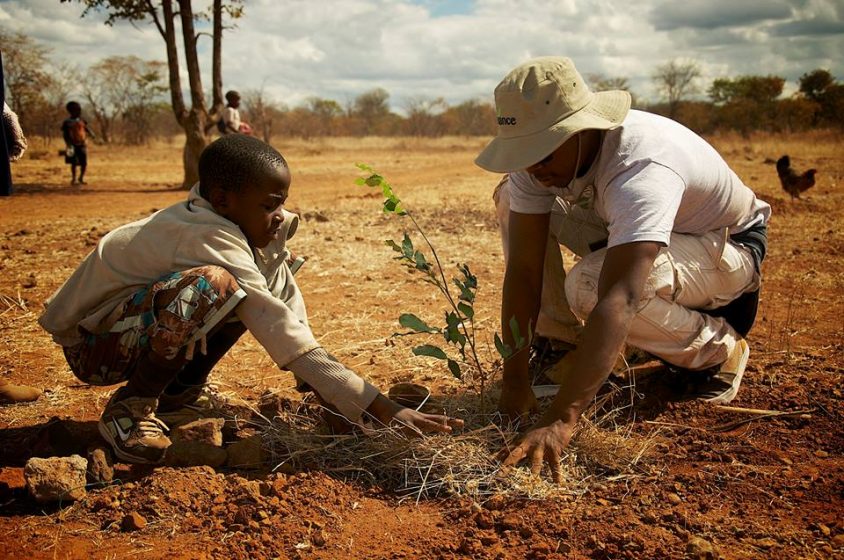
Cape Town is an extraordinary city of contradictions—historically complex and ecologically profound. Situated in one of the world’s biodiversity hot spots, the Cape Floristic Region (CFR), it is a diverse and sophisticated urban centre of great biodiversity and conservation significance but also of overwhelming inequality. The CFR was declared a National World Heritage Site of “universal significance to humanity” but very few have access to the services that this incredible biodiversity provides. The unjust economic legacies of South Africa’s apartheid enabled the rich white minority to over-consume space and water, undermining local biodiversity, while poorer citizens were forced to sprawl in areas that caused them to further degrade biodiversity and local ecosystem services.
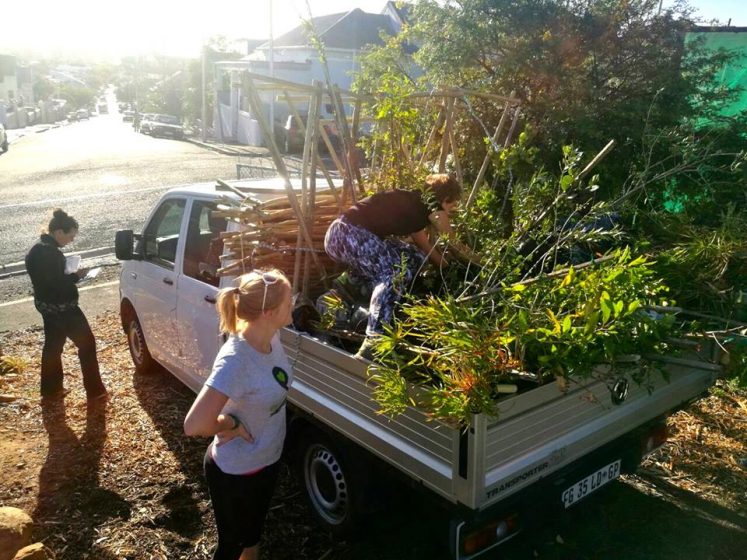
This nexus of segregation due to an apartheid legacy, high poverty levels and extraordinary biodiversity is indeed a conundrum to address. What to do with people squatting adjacent to conservation areas? How to re-nature areas without further contributing to gentrification? How to connect people to nature and achieve public buy-in of green spaces? How to make nature conservation important to people who don’t even have access to basic municipal services?
Through my work at Greenpop and our Urban Greening and Eco-education Programme (which has planted over 80,000 trees and indigenous vegetation at over 300 under-greened schools in Cape Town,) here are a few of my thoughts:
- Civic engagement in urban greening interventions can not only engender community cohesion and improved social relations, but can improve the ecological functioning and the ecosystem services provided by an area. In Cape Town, for instance, the planting of indigenous trees and fynbos attracts pollinators and birds, which in turn allows for seeds to spread and grow, in effect creating new and self-sustained ecosystem processes and services. This type of social engagement can uphold biodiversity and ecosystem services for the greater urban area while increasing the ecological linkages between other areas of biodiversity.
- Increased support for urban greening in local neighborhoods can be built and sustained over time by involving local schools in eco-education to green their own grounds and take care of green spaces through finding collaborative relations with already existing organizations. (Notwithstanding that this in turn quells the nature deficit disorder so prevalent in children in underprivileged areas, who only have dusty playgrounds to spend their formative years in—inspiring a generation of active citizens who value and are connected to nature.)
- Best-practice and lessons from smaller-scale greening interventions can be built upon and reproduced at other localities and at greater scales.
- Physically and emotionally connecting (well-chosen and appropriate) private sector funders to communities can assist in maintaining a funding stream for greening interventions in under-greened areas. International brand BOS Ice Tea, which creates their tea from South African fynbos species, Rooibos, has sponsored over 17,000 trees to Greenpop’s Urban Greening Programme. Their continued involvement is partly the result of their inspiring company ethos, but also the result of ensuring their physical involvement on plant days, where they are able to physically contribute and viscerally witness the affect their contributions are having on the community and environment.
- Civil servants need to collaborate with non-profit organizations and active citizens to access state resources to engender and sustain change on the ground, especially in neglected and marginalized public green spaces. This can be accomplished by creating effective institutional arrangements and agreements between civic associations and local authorities, allowing fruitful partnerships, increased synergy, pooling of funds and access to the workers made available from state-driven environmental initiatives.
- Effective means of monitoring and maintaining restored green spaces need to be put into place to ensure their longevity through appropriate budget allocations and community involvement. This can be bolstered by citizen science initiatives from the local community/school. (Greenpop has created a monitoring app, which allows our schools and communities to monitor our greened spaces remotely, send pictures of their development as well as ask for assistance with plant/tree health and maintenance.)
The challenges are complex and require a multifaceted approach. I don’t have all the answers, but I’ve witnessed first-hand the power of community-lead urban greening interventions in providing some light at the end of the tunnel—bringing us closer to an urban future where nature is both accessible and co-managed by active and inspired citizenry.
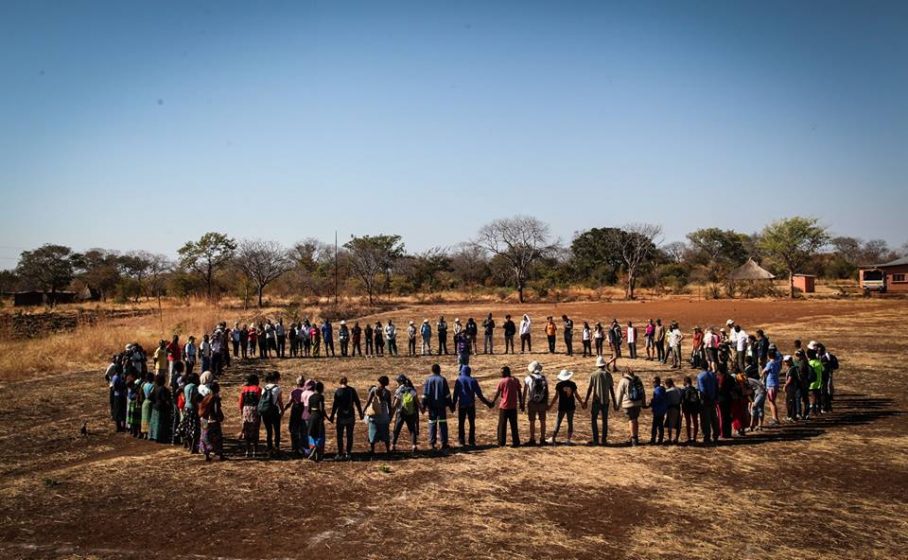
about the writer
Maggie Scott Greenfield
Maggie Scott Greenfield, AICP, serves as the Executive Director of the Bronx River Alliance and the Bronx River Administrator for NYC Parks. Maggie guides investments of more than $220 million in greenway and restoration projects, and works with multiple partners to reclaim the river as a resource for the communities along it.
Maggie Scott Greenfield
The human element: political support, cultural relevance and inclusive governance
Since its founding in 2001, the Bronx River Alliance has sought to provide access to a vital slice of nature that flows through the heart of the Bronx. It’s challenging work and progress is hard-won. The successes we’ve achieved have resulted from political will, attention to cultural relevance, and inclusive governance. All three of these human elements are particularly important when working in environmental justice communities where such projects face fierce challenges, yet where access to nature—and its related services—is most pressing.
There are no shortcuts in ensuring access to nature. We must invest in people and the systems that build political support, cultural understanding, and inclusive governance.
As a result of the Great Recession’s contracting budgets, we learned in 2008 that Starlight Park, a critical and long-awaited link in the Bronx River Greenway, would not be completed as initially envisioned. Several years later when we celebrated the opening of this 11-acre park with its docks, trails, playgrounds and sports fields, we were already strategizing on how to complete the portions that were cut. The park lacked critical connecting links to residential communities in the South Bronx, thus limiting public access. Thanks to meaningful community leadership for the river, all levels of government—Borough, City, State, Federal—heard, repeatedly and insistently, why the missing connections to local neighborhoods must be completed. Up-and-coming political stars adopted the Bronx River as a cause to champion. Long-term supporters of the river, like Congressman José E. Serrano, found new ways to sustain our efforts as the political winds shifted at the national level. This political support, rooted in broad-based community ownership of the river, has resulted in a continued commitment to “Phase 2” of the project, led now by NYC Parks, and a willingness to find new sources of funding and tackle inevitable design challenges. Now over $50 million has been allocated for Phase 2 and construction is about to commence.
Yet just as important as the physical presence of parks and trails in urban communities is cultural relevance. How do we ensure that our parks are welcoming to the multiple communities in which they are situated? Park-based programs such as Zumba, drum circles, and plant identification and cooking classes in Spanish can help connect new audiences to urban nature. But we must also recognize our own blind spots. Who will reach out to the Bangladeshi or Albanian communities? Do we even know who all our communities are in vibrantly multicultural areas like the South Bronx?
Neighborhood-based groups know their communities best and can play a significant role in facilitating access to urban nature. Recently, a Spanish-speaking instructor led a class on the medicinal properties of estafiate (a.k.a. mugwort) to a group of women at park along the river. Thanks to a partnership with Youth Ministries for Peace and Justice, a local community-based organization that secured this programming, these women were engaging with nature in a way linked to their cultural heritage. This too is access.
Finally, the institutional structure of the groups working to increase access to urban nature is of critical importance. What voice do local communities have in the decisions that shape their parks and their connection to nature? Does the staff and board of these institutions look like the communities in which they operate? If not, what can be done to move toward a direction of inclusion and representation? At the Bronx River Alliance, we support Teams for our Ecology and Greenway programs that provide a pathway for leadership and onto our Board of Directors. Several of our Board Chairs have come out of Team and community leadership. We prioritize local hiring and are proud that our Conservation Manager and Crew leaders came to us from local job training programs and have grown in roles of increasing leadership and responsibility ever since. Today, they are full-time, unionized employees with NYC Parks, demonstrating by their own success, a career path for their friends and neighbors.
There are no shortcuts in ensuring access to nature. We must invest in people and the systems that build political support, cultural understanding, and inclusive governance if we hope to approach the goal of nature for all. Recognizing the human element in the very process of connecting ourselves and one another to the great wide world around us is key to our success.
about the writer
Jim Labbe
Jim served Audubon Society of Portland’s Urban Conservationist from 2003-2016 where he led several habitat protection, access to nature, and constituency building projects. Jim is currently serving as the executive director of Depave.org. In his free time, Jim enjoys biking, dancing, studying Russian, playing music, and lollygagging in his garden.
Jim Labbe
Creating equitable biophilic cities by ending toxic urbanism
The case has been made. The evidence is in. The urbanization that destroys or degrades ecosystems and disconnects people from nature—what may now be aptly called “toxic urbanism”—is also a threat to human health and well being.
The urgent question is not should or how we end toxic urbanism and create biophilic cities. The question is whether we as communities will continue accept urban development that permits, abets, and reproduces it?
The preponderance of evidence is also clear with respect to who is most impacted by the legacy of toxic urbanism. Repeated analyses demonstrate low income people and people of color—a global majority—live in communities with less urban canopy and other green infrastructure and/or with less proximity or lower quality access to greenspace. These same demographic groups also face other social or cultural barriers at different spatial scales to the enormous health benefits of nature in cities.[iii]
We need not be bogged down in policy or technical questions as to how to more fully integrate nature and the built environment to create healthier, climate resilient cities. Issues of design and feasibility have been or are being overcome in tens of thousands of projects and experiments in hundreds of cities across the globe. Communities are learning from each other to put nature back in the city for biodiversity and human health. They are showing how to daylight urban streams; depave and regreen urban streets; incorporate green roofs, green walls, or other green infrastructure into the densest urban neighborhoods; expand and enhance the urban forest; create interlinked and nested regional systems of parks, greenways, and natural areas; and safeguard regionally critical food, forest and biodiversity lands.
So the salient, urgent question is not should or how we end toxic urbanism and create biophilic cities. The urgent question is whether urban planners, business and community leaders, and public officials continue accept urban development outcomes that permit, allow, abet and reproduce “toxic urbanism?” How can we not take bold action in implementing proven policies, finding needed resources, and focusing public attention on creating the equitable and ecological cities when what is at stake for the health of all our neighbors.
In my hometown of Portland, Oregon, a city much touted for its green urban and regional planning, we struggle to get beyond reputations and appearances to grapple with basic versions of these questions. We still ask ourselves whether we will widen freeways to achieve very dubious congestion relief. We ask ourselves whether we should exempt commercial and industrial lands from tree preservation and planting as an extremely dubious economic development strategy. We squabble over retaining outdated parking requirements or exclusive single-family zoning (sometimes, ironically, in the name of nature conservation) that locks low-income people out of affordable housing and good park access while increasing air and water pollution and exacerbating job-housing imbalances, not to mention increasing pressure for low-density greenfield development on the region’s edge.
Now more than ever, the imperative is to face political barriers to making just transitions to ecologically sustainable, biophilic cities and regions. To muster the will to act we must focus on tools and strategies that persuade the persuadable and allow the voices of disenfranchised majorities to be heard. This might start by recognizing and naming toxic urbanism and holding our leaders to account for its consequences. For many they have always been self-evident. Creating ecological, biophilic cities can no longer be the latest cache. It can’t be just about brandishing reputations of particular places or politicians to bolster tourism or attract outside investment, it must be about protecting everyone’s basic human health and ability to thrive in an equal opportunity society.
References
[i] James P, et al. 2015a. A review of the health benefits of greenness. Current Epidemiology Reports Vol. 2, pp. 131–142.
[ii] Ebisu K, et al. 2016. “Association between greenness, urbanicity, and birth weight,” Science of the Total Environment, Volume 542, Part A, 15 January 2016, pp. 750-756; Hystad P, et al. 2014. “Residential Greenness and Birth Outcomes: Evaluating the Influence of Spatially Correlated Built-Environment Factors,” Environmental Health Perspectives, pp. 1095; Markevych I, 2014. “Surrounding greenness and birth weight: Results from the GINIplus and LISAplus birth cohorts in Munich,” Health & Place Vol. 26 pp 39-46; Laurent O, et al. 2013. “Green spaces and pregnancy outcomes in Southern California,” Health & Place Vol. 24, pp. 190-195; Dadvand P, et al. 2012. “Green space, health inequity and pregnancy,” Environmental International Vol. 40 pp. 110-115; Donovan GH, et al. 2011. “Urban trees and the risk of poor birth outcomes,” Health & Place Vol. 17 pp. 390-393.
[iii] Rigolon A, 2016. “A complex landscape of inequality in access to urban parks: A literature review,” Landscape and Urban Planning, Vol. 153, pp. 160-169; Zhou X, 2012. “Social disparities in tree canopy and park access: A case study of six cities in Illinois using GIS and remote sensing,” Urban Forestry & Urban Greening Vol. 12:1 pp. 88-97; Labbe J and Radin K, 2007 Regional Equity Atlas, Chapter 12 Parks & Nature, Coalition for a Livable Future, pp. 81-92; Tan PK and Samsudin R, 2017. “Effects of spatial scale on assessment of spatial equity of urban park provision,” Landscape & Urban Planning Vol 158, pp. 139-154.
about the writer
Francois Mancebo
François Mancebo, PhD, Director of the IRCS and IATEUR, is professor of urban planning and sustainability at Reims University. He lives in Paris.
François Mancebo
Making ecosystem services and nature available does not mean making them accessible to everyone; they must be consistent with the existing social and cultural fabric.
Let’s consider a place I know well: Paris. The spatial divide in the Ile-de-France—Paris’ metropolitan region—increased significantly in the last decade, between wealthy and poor people as well as between ethnic groups (though their existence is not officially recognized in France). Surprisingly, it coincided with environmental policies focused on the development of ecosystem services. What happened? One example—the disadvantaged quartier de la Goutte d’Or east of Montmartre, bordered by railways, technical facilities, and railroad tracks—should be enough to give you some insight. What is a quartier? Officially Paris is divided in 20 arrondissements and each arrondissement is divided in 4 quartiers. But in fact that’s really not what this policy is about: the municipality calls quartier a complex entity—usually smaller than the official quartiers—which partially overlaps that of neighborhood in other countries like the USA and has no administrative status.
In the seventies the Paris City Council initiated a program of urban renewal in this deprived area: libraries, parks and gardens (square Léon and square Amiraux-Boinod) were created, as well as swimming pools (piscine des Amiraux, piscine Bertrand Dauvin). But nothing changed for the population. Nobody frequented these new libraries, parks and pools. The population stuck to its usual way of living. These amenities were perceived as threats, put there only by the will of planners and local moguls, rather than opportunities for a richer life. It was not so much a matter of access and capability really. The people decided not to use them, because they considered that they didn’t belong to their world. They built an invisible wall between themselves and these amenities. I developed these aspects in a chapter of The Just City Essays. It says that people suffering from bad living conditions, are not only victims. They also are actors whose choices, convictions and presuppositions contribute to maintain, to worsen, and even in some cases to create the condition in which they live. That is to say that making ecosystem services and urban nature available does not mean making them accessible to everyone.
As I mentioned in a former post—Unintended Consequences: When Environmental Goods turn Bad—creating ecosystem services is not inherently “just” or “good”. Parks and gardens do not necessarily bring people together. They can also isolate people because they separate their homes. This aspect is in line with the Parisian history: the introduction of greenery by Haussmann was an attempt to control the use of public space by a technical approach based on hygienism. Its main function was to bring more sunlight to the city and better the air circulation. The city life was marked by socio-spatial differentiation, virtually segregated, embodied in a type of revegetation reduced to espaces verts. The very term espace vert (green area) reveals its real nature: “…by losing its name, the old urban garden or urban park is deprived of its positive attributes excepted the hygienic one… the espace vert is no longer a place but rather an indistinct area whose boundaries are decided in the abstract world of the master-plans…”
Thus, ecosystems services must be consistent with the existing social and cultural fabric, communities, local assets and resources, to effectively provide access to everyone, especially to the people living nearby. It means that maximizing wide-scale involvement, from the scratch, of local communities and neighborhoods in the design and management of these ecosystem services is crucial to improve justice and access.
about the writer
Isabelle Michele Sophie Anguelovski
Isabelle Anguelovski is a Senior Researcher at the Institute for Environmental Science and Technology at the Universitat Autònoma de Barcelona. She is a social scientist trained in urban and environmental planning and coordinator of the research line Cities and Environmental Justice.
Isabelle Anguelovski
Who benefits from green cities?
In many large cities around the world, the public and private investors that promote the environmental, socio-economic and health benefits of urban greening projects often hide the often highly inequitable outcomes of gentrification and displacement linked to these developments. Under the banners of sustainability, resilience, and climate adaptation, a number of municipalities engaged in greening trajectories, instead of solving problems, have created new socio-spatial inequities or even exacerbated old ones.
There’s been a significant shift in green urban planning—from the community-oriented greening of the 1970s and 1980s aimed at reclaiming neighborhoods, toward a development-oriented greening aimed at attracting high-end amenities that cater to service industries, technology districts, privileged residents, and tourists.
As exemplified by the High Line in New York City, a former elevated railroad transformed into a large urban areal park now visited by 5 million people each year, many new parks have ultimately catered to white and socially-privileged residents and tourists. Between 2003 and 2011, property values near the High Line went up by 103%, and Zaha Hadid’s studio penthouses currently go for $50 million.
Since the 19th century, urban greening projects such as parks, gardens, greenways and ecological corridors have been promoted as motors of beautification, improved health outcomes, neighborhood revitalization, and residential well-being. Yet we can observe a significant shift in green urban planning—from the community-oriented greening of the 1970s and 1980s aimed at reclaiming neighborhoods, toward a development-oriented greening aimed at attracting high-end amenities that cater to service industries, technology districts, privileged residents, and tourists.
Our research at our social science research lab BCNUEJ has found evidence of this in various cities across the globe. In Medellín, the greening of poor areas in the name of growth control, beautification, and resilience is transforming low-income areas into landscapes of pleasure and privilege. In the process of green infrastructure construction such as the Greenbelt—Cinturón Verde, many residents of low-income neighborhoods are being dispossessed of community assets like land, social capital, and traditional farming practices. In New Orleans, we have observed how new green infrastructure linked to climate adaptation and its Living with Water plan mostly aim to attract a new creative, white middle class that can afford to purchase newly built waterfront property, while overlooking long-term inequities in land use development and promoting the creation of ecological enclaves. In Barcelona, one of our recent studies finds clear green gentrification trends in several historically underserved areas, especially old industrial neighborhoods. In the Sant Martí district, for instance, the percentage of residents holding a bachelor’s degree or higher increased by nearly 28 percent on average around a new local park, versus only a 7.6 percent increase for the district as a whole over a period of 10 years. The data clearly demonstrates how new green space attracts higher-educated residents.
Such far-reaching dynamics raises questions for environmental justice groups. As activists organize around improving urban environmental quality for socially-vulnerable residents, they are increasingly faced with the inequitable outcomes associated with greening projects promoted by powerful private investors and municipal decision-makers under a utopian language of sustainability and quality of life. So much so, that the growing trend of land revaluation and displacement that often results from greening has earned itself the term “green gentrification” or “ecological gentrification” (Dooling, 2009; Checker, 2011), in which gentrification is characterized by the social erasure of residential practices as well as by real physical displacement.
At BCNUEJ, our long-term research asks: Do urban greening projects have win-win outcomes for urban residents, as municipal leaders and planners widely claim? Or do they benefit some groups more than others? To what extent do different green planning interventions translate into the creation or exacerbation of new environmental inequalities through new dynamics of exclusion and invisibilization? Through our research project GREENLULUS—Green Locally Unwanted Land Uses—we examine the conditions of this green space paradox in different cities and its implications for long-term marginalized urban residents. We use the terms “GREENLULUS and green space paradox” to describe new or restored green amenities in historically marginalized communities as a way of repoliticizing a post-political sustainability discourse and to point to the fact that green projects do not always—and in fact, seldomly—bring positive outcomes for all city dwellers.
Of course we do not think the solution is to avoid greening in low-income neighborhoods or communities of color. Such decisions would further exclude historically marginalized groups from the benefits of greening and concentrate green or sustainability investment in richer neighborhoods. Nor do we argue that planners intentionally target low-income neighborhoods and communities of color in order to profit developers and exclude vulnerable residents from the benefits of green projects. Our research points to the fact that planners are more likely to neglect the impacts of their plans on the exchange values of real estate and that they are often imprisoned in a logic of competitive urbanism and city rebranding even if they are becoming increasingly aware of the inequitable impacts of green planning.
The question and challenge thus becomes: How can cities craft regulations, policies, planning schemes, funding mechanisms, and partnerships that address the negative impacts of green planning? In short, how can everyone benefit from green cities?
Many believe that lasting solutions to address urban green inequities and green gentrification reside in changing the ownership of land in cities so that its speculative and market function and place gets taken out of the picture. This means developing tools such as Community Land Trusts or Mutual Housing Associations, which are increasingly relevant policy tools used to address gentrification. Protecting and further developing social housing and public housing is also an obvious commitment needed to mitigate the risks of displacement increasingly associated with large scale urban greening projects such as greenways.
Zooming in on the greening projects themselves, smaller-scale projects focused on the needs, preferences, and multiple uses of local residents also have the potential to help ensure interactional justice and community ownership and stewardship—rather than appropriation by visitors and tourists, as The High Line exemplifies.
A version of this contribution appeared previously at the Barcelona Laboratory for Urban Environmental Justice and Sustainability (BCNUEJ).
about the writer
PK Das
P.K. Das is popularly known as an Architect-Activist. With an extremely strong emphasis on participatory planning, he hopes to integrate architecture and democracy to bring about desired social changes in the country.
P.K. Das
Know ecosystem services?
We make strong claims at TNOC about the importance of ecosystems. But how should a poor person in a slum care of these against basic deficits in safe water, housing, and human rights?
How many people know what ecosystem services mean? Maybe none, with a miniscule exception, among those with whom I work and engage on every day basis in Mumbai. These people include, politicians, middle- and upper-class citizens, slum dwellers, workers, activists, journalists, educators, historians, sociologists, economists, engineers, architects, planners and municipal and government officials. We engage in a substantially wide range of matters that affect our daily lives, consuming our time and energy; open spaces, gardens, beaches, waterfronts, creeks, wetlands, mangroves, forests, trees, quality of life and environment and housing, and a host of other urban development issues- transportation, city planning and so on, human rights and law included.
Therefore, the challenge is, as I understand, first introducing the very idea of ecological services into our dialogue, relating them with other rights and thereafter building popular movements for claiming and reclaiming access by all to ecosystem services. Let me confess, here in Indian cities, we are far from it.
I live and work in Mumbai, a city of twelve million people, the financial and trading capital of India. Real estate prices here are amongst the highest in the world; while over 50% of its population—six million people—live in slums. Services and infrastructure in the slums and the city, are probably the worst among big cities anywhere.
Interestingly, Mumbai has a long history of a number of significant social and political movements: struggles of the discriminated Dalit people led by Dr. Ambedkar, unionization of the working class led by Dange, the Quit India movement against British occupation led by Mahatma Gandhi. Also, there have been significant struggles for housing rights, civil and civic rights, human rights and important environmental battles, thereby influencing the city and the country.
Mumbai is also unique in terms of the extent of its rich and varied natural areas and assets. Forests including a 100 km2 national park within the city, hills, creeks, wetlands, mangroves, beaches, rivers, lakes, together covering an area of 240 km2 that constitute 50% of the total area of the city.
Tragically, development of the city, historically, has been directed with just one single dominating motive, that is to boost real estate business, with volumes of mindless construction as a measure of success, thereby turning the city into a speculative investment heaven by the rich and influential people. As a result, natural areas have been abused and misused, turning them into dumping grounds, both physically and metaphorically. Destruction of these areas has been rampant with irreversible environmental consequences. Even an account of these rich natural assets of the city have not been mapped or documented sufficiently. The preparation of successive Development Plans by the city Municipal Corporation every 15-20 years have ignored them as being integral to the planning process. Over the years, large parts of these areas have been landfilled in order to promote real estate projects. Currently, the government is pushing for development of the saltpan areas (parts of the wetlands that have been used since the 1940s to produce salt) for promoting affordable housing schemes. Similarly, large parts of the national park are being de-reserved for construction of roads, transportation depots and similarly other projects.
It is in such a complex context of socio-political history and un-sustainable urbanization that is being pursued by the governments in Mumbai, indeed across India, that we have to dwell upon the subject of ecological services.
As The Nature of Cities, of which I am a part, makes strong claims about the critical value of nature and ecosystems, my concern is how can various people’s movements in the city successfully include this issue into their agenda and popularize them as being integral to questions of resilience and sustainability. Such an effort would mean going beyond their preoccupation with demands from people for day to day needs—basic services like safe drinking water and sanitation and housing and protection of human rights. In such a situation, how can we champion the benefits of green to be true and real? How can we consciously evaluate those services that already exist, but of which we are not particularly aware, while simultaneously furthering new ones?
Can The Nature of Cities prepare, to begin with, a short campaign leaflet, brochure and posters for public understanding? Various movements here can then use them or appropriately modify them to spread the message and conduct public discussions. Governments will be forced to look into these concerns once there is growing public understanding of the significance of ecosystems services and their rights of access.
about the writer
Marthe Derkzen
Dr. Marthe Derkzen is a researcher and lecturer with the Health and Society chair group. She studies urban nature from a social justice perspective with an interest in climate adaptation, local food, healthy neighborhoods and stewardship of the commons.
Marthe Derkzen
Share your garden & green your school ground!
Collaborative programs that foster civic engagement increase equity in nature access by opening up green areas to residents of all ages and backgrounds, including those for whom access to nature is not a standard privilege.
I spent the past four years studying the benefits of urban nature with a particular emphasis on ecosystem services and social justice. My PhD research included case studies in Rotterdam and Bangalore, and in spite of being very different cities, they show a similar problem: current green space planning fails to take everyone’s needs into account, and the groups least able to raise their voice face the risk of becoming further marginalized. The closer I came to the end of my PhD, the more I realized that civic engagement can help solve this problem. I will present two promising avenues for a greener city by and for local groups and residents, based on my experience living and working in Amsterdam.
Amsterdam is a compact city that wants to expand without expanding. The city is growing and needs to build more housing, while maintaining its high livability standards. This means that pressure on public green spaces is constant and every square meter should be highly functional without sacrificing quality. So what to do? Here are two simple solutions for increased nature access in compact cities:
1. Green school grounds
Ideally, every child should interact with nature on a daily basis. In compact cities it is more rare than common for houses to have a garden, so this daily portion of nature should be sought elsewhere. The school ground is the perfect location to include green playgrounds, water channeling games, green walls with herbs and a garden filled with strawberries. A green school ground is the perfect source of learning by doing, stimulates the exploratory mind and has proven to increase indoor concentration as well (see the work of Sjerp de Vries on green school ground redevelopment). Besides the educational benefits, green school grounds are perfect for cross-cultural meetings, parents’ active involvement, neighborhood networks and rain water infiltration. Most importantly, they provide an opportunity for every child to access nature, regardless of their home situation.
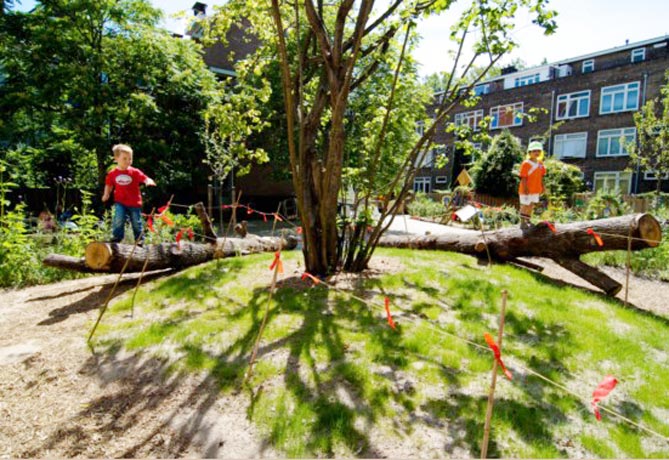
2. Garden sharing
Another simple solution based on engagement and neighborhood ties, is the concept of garden sharing. The Amsterdam based organization De Gezonde Stad (The Healthy City) is currently testing a platform for garden sharing in two neighborhoods. The idea is simple: connect garden owners who currently don’t manage their garden spaces to their neighbors with an interest in gardening but no garden space. In Amsterdam, garden owners often lack the time or energy to maintain their garden which is why many gardens are either sealed, grey spaces or have turned into a complete wilderness. Other garden owners have lost the physical ability to maintain their garden because of age or poor health, and some just lack a green thumb. This is a sad situation as many garden owners would really like to have a lush green garden, either to grow vegetables or simply to have a nice outdoor space in which to relax. It becomes even sadder knowing that there is a huge army of Amsterdam residents who would love to have a garden but who live in small apartments with tiny balconies, if any outdoor space at all. The garden sharing platform, called My Plot, connects garden owners to garden cravers and makes them both happier. Creating not only increased equity in nature access, but also increasing the share of unsealed and vegetated surface area!
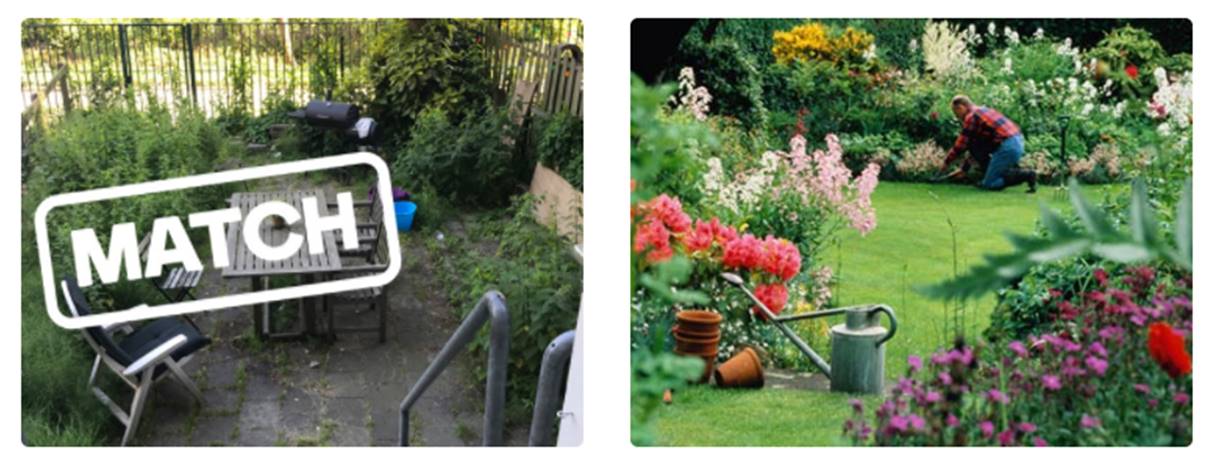
These examples of civic engagement and collaboration increase equity in nature access by opening up green areas to residents of all ages and backgrounds, including those for whom access to nature is not a standard privilege. But it is not a task for residents and local organizations alone. Municipalities have a task to support and facilitate bottom-up initiatives, for example through subsidies and planning legislation that allows new collaborations and adaptive uses. At the same time, municipalities are responsible for maintaining safe and healthy cities and need to keep exploring novel top-down solutions such as a garden taxing system that favors permeable garden owners over sealed garden owners in order to increase rain water seepage into the soil. Cities should make use of the current momentum in which urban nature gains attention for reasons of health, local engagement and resilience to climate change.
about the writer
Pengfei XIE
Pengfei is China Program Director of RAP (Regulatory Assistance Project). RAP is a US based non government organization dedicated to accelerating the transition to a clean, reliable and efficient energy future.
Pengfei XIE
Let us build more Green Infrastructure in urban areas
In an ideal situation, everyone would have equal access to nature and enjoy the benefits of ecosystem service. I strongly agree and support this view. However, in real life, the opportunity to access nature is usually unequal, which may affect the well-being of the general public.
I am happy to observe a tendency in Chinese cities that local stakeholders are more and more involved in the GI, introducing initiative in urban areas.
According to the European Commission, GI is a strategically planned network of natural and semi-natural areas with other environmental features designed and managed to deliver a wide range of ecosystem services. It incorporates green spaces and other physical features in terrestrial (including coastal) and marine areas. It is significantly helpful in solving urban and climatic challenges that plaguing our cities today.
I don’t want to specify the details of GI in theory and practice; the point I want to highlight here is that we should mobilize communities and individuals to actively participate in building GI according to local conditions. The two stakeholders at the basic level (community and individual) need to create benefits of ecosystem service for themselves, rather than only wait passively and complain about the situation until local governments come to help. GI projects sometimes could be small projects that communities and individuals are able to fulfill, as they know the local conditions and needs better.
I am happy to observe a tendency in Chinese cities that local stakeholders are more and more involved in the GI, introducing initiative in urban areas. (1) A famous university committed to build a green campus in Shanghai, and is mobilizing the college students to produce designs and plans to renovate the campus. One idea is to transform the previous ditch into wetland. The project was successfully adopted by the university. (2) An urban community in a southern Chinese city implemented a green roof plan that is financially viable with the support of community residents. (3) A household contracted a small piece of unused land in the community, and planted vegetation cleverly. The barren land is now covered by green.
These self-motivated actions not only bring nature closer to individuals, but also provide ecological benefits to the residents.
about the writer
Suraya Scheba
Suraya is a lecturer in the environmental and geographical sciences department, and postdoctoral researcher within the African Centre for Cities, at the University of Cape Town. She is interested in examining the politics and power geometries engaged in producing unjust urban forms, and relatedly the possibilities that exist in opening-up more just alternatives.
Suraya Scheba
How will we achieve universal access to ecosystem services and urban nature?
The current inability of the mainstream sustainable development agenda to address the destructiveness of capitalist metabolism, as it seeks to offer guidance for the next 20 years of urbanization, renders it largely impotent.
According to Joan Clos, the Executive Director of UN-Habitat, the 2016 World Cities Report unequivocally demonstrates that the the current urbanization model is unsustainable in many respects and needs to change to address issues such as inequality, climate change, informality, insecurity, and the unsustainable forms of urban expansion (United Nations, 2016). That is, cities are responsible for 70-80 percent of the world’s use of resources and most of the world’s waste, making them the key sites for confronting environmental degradation. They are also sites of widening inequality and exclusion, with 75 percent of the world’s cities having higher levels of income inequalities than two decades ago. Within this context, many cities today fail to make sustainable space for all (United Nations, 2016).
The dominant response to this pattern of unsustainable urbanisation, at a global scale, has come in the form of the Sustainable Development Goals (SDGs) and linked New Urban Agenda. Spurred on by more than two decades of mainstream sustainable development thinking, these agendas advocate a win-win market logic. In other words, they argue for the mobilization of eco-technical rationality, good governance, and behavioral change — all within the market — in order to deliver sustainable, just and inclusive urbanism. It is argued that the New Urban Agenda suggests a “paradigm shift” for pursuing the SDGs. However, despite this proclamation of “newness”, it remains path dependent on old methodological tools (e.g. indicators), techno-managerial solutions (e.g. smart cities), and institutional frameworks of ecological modernization (Kaika, 2017).
Following Urban Political Ecology, I believe that this is a deeply insufficient and problematic response, as it naturalises capitalism and consequently narrows the possible conversation that can be had on the emergence of more equitable and democratic patterns of urbanisation. In contrast, a more productive and radical response would be to bring into question the current mode of production, which, under capitalist social relations, prioritises the realisation of exchange value over use value . The dominance of exchange value promotes unsustainable consumption, extraction, and exploitative labour practice, in pursuit of accumulation. It is this logic of capitalist metabolism, that is responsible for our unsustainable mode of urbanization and therefore cannot constitute a central part of the solution! If we are to achieve universal, and more importantly equitable, access to the city (as socio-nature) what is needed is a fundamental challenge to this naturalisation of capitalist metabolism, as a central driver in the production of unsustainable urban forms at a global scale. The current inability of the mainstream sustainable development agenda to address the destructiveness of capitalist metabolism, as it seeks to offer guidance for the next 20 years of urbanization, renders it largely impotent.
Hence, in answering the question of “how just universal access can be achieved?”, I believe we need to question the very notion that “sustainability” can be achieved through engineering away the problem. Instead we need go deeper, into the heart of the problem, by unravelling the centrality of the techno-managerial focus of contemporary environmental governance, and moving instead toward a political conversation on how more equitable and democratic modes of governance and urbanisation can emerge (Swyngedouw, Kaika; 2014: 473). ria Kaika (2017), argues that the mainstream vision can only vaccinate “citizens and environments so that they can take larger doses of inequality and degradation in the future” (Kaika, 2017: 89), but does little towards meaningfully addressing the effects of global socio-environmental inequality. Within this context, an increasing number of communities are declining these packaged solutions and choosing instead to rupture this path dependency, aiming to establish effective alternative methods for accessing housing, healthcare, sanitation, etc. These dissensus-practices — chosen over the consensus-building offered through formal channels – are evidenced in Cape Town, Mumbai, New York, Barcelona, and many other cities across the world. We would do well to pay attention to these practices as they bring to our attention the grounded urgent needs to be addressed. This is how we might move toward a more radically transformative new urban agenda. One that ruptures, as opposed to perpetuates, the status quo.
References
Kaika, M. and Swyngedouw, E., 2011. The urbanization of nature: Great promises, impasse, and new beginnings. The new Blackwell companion to the city, pp.96-107.
Kaika, M., 2017. ‘Don’t call me resilient again!’: the New Urban Agenda as immunology… or… what happens when communities refuse to be vaccinated with ‘smart cities’ and indicators. Environment and Urbanization, 29(1), pp.89-102.
UN-Habitat, 2016. Urbanisation and Development: Emerging Futures. World Cities Report 2016. UN-Habitat, Nairobi, Kenya.
about the writer
Hita Unnikrishnan
Dr. Hita Unnikrishnan is an Assistant Professor at The Institute for Global Sustainable Development, The University of Warwick. Hita’s research interests lie in the interface of urban ecology, systems thinking, resilience, urban environmental history, public health discourses, and urban political ecology as it relates to the evolution, governance, and management of common pool resources in cities of the global south.
Hita Unnikrishnan and Harini Nagendra
Urban commons—for whom and for what?
In today’s rapidly urbanizing world, the critical roles of equity, justice, and sustainability have long since been recognized. The Sustainable Development Goals (SDGs) formulated by the United Nations makes explicit mention of Sustainable Cities and Communities within the contexts of equity and justice. But despite the fact that these elements of resilient cities have been recognized and measures taken to bring in some semblance of equitability and sustainability, cities of the global south such as Bengaluru, India, have operated historically and continue to do so through regimes fostering inequity, albeit through unintentional mechanisms.
Actions taken seemingly for the benefit of the resource (patrolling by guards, fencing, priced entry) often reveal a cultural imagination of nature that is dominated by the aesthetic and recreational, while exacerbating existing inequities in access to ecosystem services.
The advent of centralized piped water supply systems in the late 19th century disrupted the dependence on the commons, and fragmented community groups. Groups such as fishers and grazers, who derived material benefits from urban commons, began to be excluded as aesthetic and recreational values of natural spaces began to dominate. These resource users began to be excluded from important decision-making processes relating to these spaces as well, as a result of which many of Bengaluru’s lakes and wooded groves were converted to built spaces. A case in point is Bengaluru’s centrally located Sri Kanteerava Stadium, built on one of the city’s largest lakes, Sampangi lake.
Such exclusions are not restricted just to the past either. Recent experiments with private-public partnerships for lake management in Bengaluru have commoditised the urban commons, severely restricting the range of services available to traditional users based on their ability to pay. Many state and community-led lake restoration efforts also prioritize the values and needs of wealthier residents, but exclude marginalized resource users such as farmers and grazers, from access as well as from decision making. Consequently, actions taken seemingly for the benefit of the resource (such as patrolling by guards, fencing, and pricing entry) often reveal a cultural imagination of nature that is dominated by the aesthetic and recreational, while exacerbating existing inequities in access to ecosystem services.
Regardless of the form of exclusion—historic or present day; caste and community based, or on the basis of income—inequities in access to nature’s benefits are mostly borne by those who are already marginalized. Ironically, these are the people most dependent upon the resource to sustain their lives and livelihoods. Which begs the question: who really are urban commons for? And what is the best way to move forward?
Attempts at bridging the gap exist, though few in number and small in scope. Some community efforts to restore lakes in Bengaluru have attempted to address inequities by collaborating with diverse groups ranging from livestock owners to school children. An initiative by BIOME Environmental Solutions aims at restoring open wells in collaboration with a community of traditional well diggers, helping to improve water sustainability while empowering this marginalized but highly knowledgeable group. In a series of activities aimed at driving experiential learning on sustainability issues, a collective led by the city based organization—Daily Dump, has encouraged school students to engage with urban commons in the form of what might seem like an uninspiring space under a flyover, speaking to diverse people that use the space, such as drivers of buses, and street vendors, and tweeting their experiences using the hashtag #undertheflyover.
It is very well to state that inequity may be resolved by ensuring inclusive access to ecosystem services, but the road towards ensuring that equity is still fraught with challenge, situated on a foundation of often well-meaning exclusionary regimes. We need to highlight, study, and better understand such examples of collaborative community led efforts to ensure that diverse groups get access to ecosystems in the highly unequal urban contexts of today’s cities—to facilitate conditions for expanding these efforts at a larger scale.
[second_bio]
about the writer
Harini Nagendra
Harini Nagendra is a Professor of Sustainability at Azim Premji University, Bangalore, India. She uses social and ecological approaches to examine the factors shaping the sustainability of forests and cities in the south Asian context. Her books include “Cities and Canopies: Trees of Indian Cities” and “Shades of Blue: Connecting the Drops in India’s Cities” (Penguin India, 2023) (with Seema Mundoli), and “The Bangalore Detectives Club” historical mystery series set in 1920s colonial India.
about the writer
Fadi Hamdan
Fadi has more than 25 years of international experience in analysing the interaction between development, urbanism, disaster risk, climate change, conflict, and state fragility. Fadi cooperates with various companies, cities, and countries to protect people, assets, and the environment
Fadi Hamdan
Ecosystem benefits—a service for the few or a right for the many?
In this intervention, I attempt to address the issue of inequality of access to ecosystem benefits, not as a stand-alone issue, but rather within the broader context of ongoing trends of urbanism, multi-dimensional inequality, poverty, disaster losses, financialisation of the global economy and climate change.
The issues of this roundtable are in fact multi-dimensional and multi-scalar: the social processes that drive the disaster risk, climate change, poverty nexus are permeated with rising inequality.
Ecosystem benefits such as crop pollination, carbon sequestration, climate regulation, water purification, air purification, nutrient dispersal, nutrient recycling, waste processing, flood control, pest control and disease control, are estimated to be around $36 trillion a year. Currently, we remain unable to provide these services for ourselves[iv]. The ecological footprint from the unsustainable overconsumption of energy and natural capital now exceeds the planet’s biocapacity by nearly 50 percent. Coastal wetlands declined by 52 percent between the 1980s and early 2000s. Other critical regulatory ecosystems such as mangrove forests and coral reefs are also degrading at a rapid pace[v].
The mortality and economic losses associated with extensive risks (minor but recurrent disaster risks) in low and middle-income countries are trending up. In the last decade, losses due to extensive risk in 85 countries exceeded US$94 billion. Extensive risks (which represent an ongoing erosion of development assets, such as houses, schools, health facilities, roads and local infrastructure) are usually absorbed by low-income households and communities and small businesses. While the concentration of investment in urban centres drives intensive risk (severe but relatively infrequent risk), high levels of urban income inequality shape patterns of extensive risk[vi].
The social processes that drive the disaster risk, climate change, poverty nexus are permeated with rising inequality. Indeed, in 2017 eight people own as much as 3.6 billion people who make up the poorest half of humanity[vii]. Rising inequality is manifesting itself in both the global south and the global north, where for example research by Piketty shows that over the last 30 years in the U.S., the growth in the incomes of the bottom 50% has been zero, whereas incomes of the top 1% have grown 300%[viii].
Building asset inequality (housing and security of tenure), unequal access to public services and welfare systems, inequality of social status linked to space (e.g. informal settlements in urban settings), and inequalities in the application of the rule of law has significant impact on disaster risk levels. Inequality itself, including inequality to access to basic ecosystem benefits, is permeated with weak governance and weak risk governance. For example, from the global, through to the sub-national levels, decisions relating to the use of resources lead to a particular distribution of benefits, exposure, vulnerability, risks and losses. Often the poorest, the most marginalized, and those with the least (unequal) access the decision making process are those that suffer disproportionately from a concentration of vulnerability and losses due to the particular use of the natural resources.
Communication technologies allow people to connect and lobby for their rights at the local, national and global levels[ix], including the right for access to eco-system benefits, thereby circumventing gatekeepers at all levels. However, increased financialisation of the economies in first world countries[x], [xi] and prevailing rentier economies and cultures in many third world countries[xii] is leading to the breakdown of traditional social contracts, and to the rise of racism and other forms of extremism that prevent people from uniting around rights-based themes.
Notwithstanding the above, climate change, rising inequality, increased disaster losses, and improvements in education and telecommunications technologies provide an opportunity to:
- Raise awareness on the relationship between weak risk governance and the disproportionate concentration of disaster risk vulnerability and losses.
- Use telecommunication technologies to lobby and mobilise support for preserving and promoting ecosystem benefits for all.
- Pillar the above two steps on the fundamental idea that ecosystem benefits are a human right to be enjoyed by all and not a service to be enjoyed by the decreasing few who can afford it.
References
[i] The World Cities in 2016 – Data Booklet, United Nations, Economic and Social Affairs Division. http://www.un.org/en/development/desa/population/publications/pdf/urbanization/the_worlds_cities_in_2016_data_booklet.pdf
[ii] Slum Almanac 2015/2016, Tracking Development in the lives of slum dwellers, UNHABITAT, 2016. https://unhabitat.org/wp-content/uploads/2016/02-old/Slum%20Almanac%202015-2016_EN.pdf
[iii] According to the above study, this number may be considered as a minimum as this figure has been calculated considering just four out of the five slum household’s deprivations considered in UN-Habitat’s definition, as security of tenure can’t be accurately calculated yet. In some countries with limited information, only one of the five components has been measured.
[iv] Abundance – the future is better than you think, Diamandis P. and Kotler S., 2011.
[v] Global Assessment Report, UNISDR, 2015.
[vi] Global Assessment Report, UNISDR, 2015.
[vii] An Economy for the 99%, Oxfam Briefing Paper, January 2017. https://www.oxfam.org/sites/www.oxfam.org/files/file_attachments/bp-economy-for-99-percent-160117-en.pdf
[viii] Capital in the Twenty First Century, Thomas Piketty, 2014. https://dowbor.org/blog/wp-content/uploads/2014/06/14Thomas-Piketty.pdf
[ix] Abundance – the future is better than you think, Diamandis P. and Kotler S., 2011.
[x] The Financialization of the American Economy, Krippner G., Socio- Economic Review, Issue 3, pp. 173-208, 2005. http://www.hr.fudan.edu.cn/_upload/article/b5/5e/e816d9f3439c946642016999bf90/b40e0f40-6867-43e0-83c5-5c1107dbe24e.pdf
[xi] Financialization and the World Economy, Epstein G., 2005.
[xii] Intensive and extensive disaster risk drivers and interactions with recent trends in the global political economy, with special emphasis on rentier states, Hamdan F., Special Issue of the International Journal for Disaster Risk Reduction, Vol. 14, Part 3, pp 273-289, 2015. http://www.sciencedirect.com/science/article/pii/S2212420914000740
about the writer
Julie Bargmann
Julie Bargmann is the founder and principal of D.I.R.T. studio in Charlottesville, VA. She is internationally recognized as an innovator in the design and construction of regenerative landscapes. Her distinctive point of view on urban and industrial sites challenges conventional remediation practices, often with groundbreaking results.
Julie Bargmann
Orange is the new green
Don’t get me going on green being used as a verb!
I fear that the stand-in “green” inhibits the appreciation for the plentiful forms the landscape (and nature) can take. If terminology around ecosystems articulated a broader spectrum of places within them, might the question of equal access to the ‘natural world’ change? If recognizable leafy flora doesn’t predominate a place, does that pose a threat to accessing nature? For me, someone obsessed with industrialized terrain, orange is the new green. Novel ecosystems are veraciously colonizing rusty manufacturing sites and engulfing toxic industrial flows. These are the landscapes that a good many people live and work in. Pumpkin-colored streams flow through coal country and when working there, local kids asked me why the water looked that way. I explained the effects of acid mine drainage to them and now they know why there are no fish. Still, they shrugged and road off on their bikes to play in the creek, in water not poisonous to their bodies but to other beings of the food chain. That’s their nature and it isn’t green.
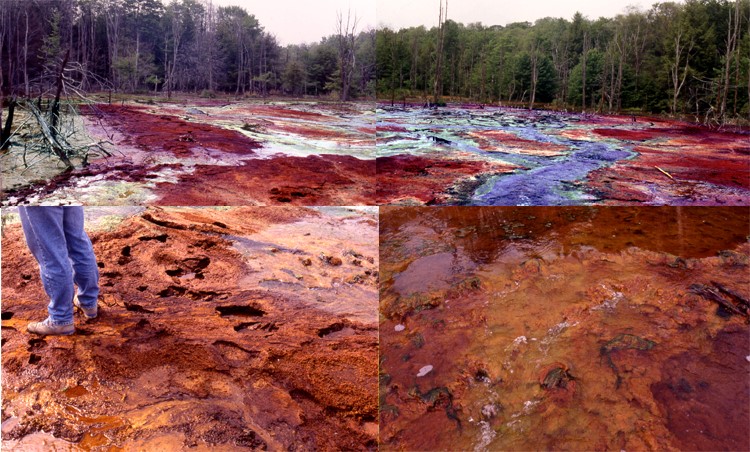
about the writer
Marcelo Lopes de Souza
Marcelo Lopes de Souza is a professor of socio-spatial development and urban studies at the Department of Geography of the Federal University of Rio de Janeiro.He has published ten books and more than 100 papers and book chapters in 6 languages
Marcelo Lopes de Souza
The “common good”—what an ambitious expression! As far as environmental protection is concerned, governments want us to believe that it is always performed precisely for the sake of the “common good”, or “public interest”. However, things are not that simple.
The spectre of “gentrifying conservationism” and “green evictions” will increasingly haunt segregated spaces and poor communities worldwide, using the “common good” argument as a convenient excuse.
The reality that inspired me to suggest the expression “gentrifying conservationism” some time ago was in Rio de Janeiro, more specifically the tensions that have taken place in the buffer zone of the Tijuca National Park. There, a pro-environment and at the same time clearly anti-popular alliance has been especially developed in last decade. Located right in the heart of the city, the slopes of the Tijuca massif influence the landscape of many neighborhoods of the city—ranging from the privileged areas of the South Zone to many favelas. Of enormous relevance is the fact that the Tijuca massif comprises the 39.5 square kilometers Tijuca National Park. The strip of land that is the most densely populated portion of the buffer zone of the park is a perfect laboratory for watching the (geo)political instrumentalisation of the ecological discourse by agents directly or indirectly involved in the attempt to implement what could be termed a sort of non-murderous social cleansing.
A veritable crusade has been carried out by the public prosecutor’s office for environmental and cultural heritage issues of the state of Rio de Janeiro. According to that office, the favelas located in the buffer zone of the park are expanding rapidly and in aggregate form “a single spot comparable to Rocinha” (one of the largest favelas in Brazil and the largest one in Rio de Janeiro, whose population has been estimated at 200,000 inhabitants). Statements like this, as well as other comments made by public prosecutors, environmentalists, and others about the danger represented by the presence of informal settlements close to the park have been frequently published above all by Rio’s biggest newspaper, O Globo.
The corporate media has played a decisive role with regard to promoting an asymmetrical treatment of social classes by the state apparatus in Rio de Janeiro, and although the public prosecutor’s office has been the main institutional agent of the current attempt to promote the total or partial removal of the favelas located in the Tijuca massif, it can be said that its role has not only been made public and highlighted but probably also stimulated by mainstream media.
But the available data do not support the idea that the favelas of the Tijuca National Park’s buffer zone are expanding rapidly; according to reliable census data and even the municipal government’s own data, offered by the Pereira Passos Institute, this is far from being the case. Monitoring data based on satellite images from 1999-2013, carried out by the Pereira Passos Institute, make clear that the spatial growth of favelas in the buffer zone ranged from nothing to very little. Ten years after it was proclaimed, in 2006, that the favelas around Tijuca were expanding rapidly, this statement can finally be declared false. Likewise, the contention that these mostly small favelas are a threat to biodiversity can be declared contrary to fact. Moreover, while the public prosecutor’s office and the corporate media continue their anti-favela crusade, residential encroachment of the buffer zone by the middle class is left undisturbed, even where it occurs close to a favela targeted for removal. Clearly, the occupation of the same location by the middle class is not regarded by the state apparatus as an environmental threat.
In a book chapter on New Delhi, Asher Ghertner used the expression “green evictions”—a happy choice of words to express a very unhappy situation. He points out the “metonymic association between slums and pollution”, what seems to justify for Indian courts “slum removal as a process of environmental improvement”. If we expand the first remark a little bit—by means of including things such as environmental degradation and related ideas as part of the second term of that metonymic association—we can easily arrive at a description of Rio de Janeiro and many other, similar cases. In fact, “gentrifying conservationism” and “green evictions” (or “green displacement”, in more general terms) seem to be inextricably linked with each other, particularly (but by no means exclusively) in the Global South.
Factors such as the immediate cause or motivation, the role of specific organs of the state apparatus and of other agents (e.g. the corporate media and middle-class residents) and the way how affected poor people will react to threats of removal will obviously vary from case to case. However, one thing is certain: the spectre of “gentrifying conservationism” and “green evictions” will increasingly haunt segregated spaces and poor communities worldwide, using the “common good” argument as a convenient excuse.
A longer version of this essay appears here.
References
Ghertner, D. A. 2011. “Green evictions: Environmental discourses of a slum-free Delhi” in Peet, R. et al. (eds.): Global Political Ecology. London and New York: Routledge.
Souza, M. L. de 2016a. “Urban eco-geopolitics: Rio de Janeiro’s paradigmatic case and its global context”. City, 20(6), 765-785.
Souza, M. L. de 2016b. “Gentrification in Latin America: some notes on unity in diversity”. Urban Geography, 37(8), 1235-1244.
about the writer
Nathalie Blanc
Nathalie Blanc works as a Research Director at the French National Center for Scientific Research. She is a pioneer of ecocriticism in France. Her recent book is Form, Art, and Environment: engaging in sustainability, by Routledge in 2016.
Nathalie Blanc and Flaminia Paddeu
Less than social movements, we need to think more of the socio-environmental communities, which are formed through joint action on a material environment.
However, cities still lag behind in evaluating the environmental value of these urban transformations, in terms of their ability to mitigate the effects of climate change. In the context of ecological transition, significant territorial inequalities, and the rise of ecological alternatives, what kind of urban fabric, and what governance must be implemented to face the challenges associated with ecological transformation?
Our hypothesis is that ecological transformation involves citizen mobilization, the cultural transformation of relationships with the environment. Since the 1970s, civil society has played an important role in the struggle for a more just distribution of collective resources such as nature spaces (Castells, 1983). Social movements have played a major role in negotiating diverse interests to defend the claim of space for urban nature (Barthel, Parker and Ernstson, 2015). These movements participate in a struggle for the urban commons such as the quality of water or air, in the face of its structural appropriation and destruction by the mode of contemporary urbanization. However, they remain ambivalent, conflict-ridden, structurally socio-economically, culturally and racially, and subject to the risk of ecogentrification (Dooling, 2009). A. Newman (2011) has highlighted, from the case of the Jardins d’Éole in the 19th arrondissement, a low-income, mainly immigrant neighborhood in Paris, the dynamics of the protest mobilized around the construction and design the park and its impact on class, gender and ethno-racial inequalities. It shows the contradictory results of these mobilizations, offering the inhabitants a new way of dealing with injustices, but reproducing at other times the socio-spatial inequalities.
Less than social movements, we need to think more of the socio-environmental communities, which are formed through joint action on a material environment—landscapes, life environments, environments— thought in the context of solidarities but also conflicts of territoriality, in which human collectives associate with the living and the environment to fight against other uses of space. These arrangements draw alternatives by shaping combinations between humans and nonhumans that open up new perspectives of action. Thus the transformation of the environment in which these inhabitants live develop a sense of alliances and bond that draws on socio-ecological processes that go well beyond the boundaries of their own local habitat.
In this sense, the notion of interspecific alliances between humans and non-humans developed by K. Beilin (2017) about the use of the amaranth Kiwicha made by the peasants and environmental activists of Paraguay and Argentina allows us to move away from a purely utilitarian approach of collectives using environmental initiatives to appropriate and shape in their own way collective spaces shared between different social groups, and a depoliticized approach assuming that ordinary environmentalism is a beneficial ecological action devoid of stakes of power.
What we call ordinary environmentalism is to take into account environmental practices that have hitherto been considered negligible and to emphasize their valorization in the case of a democratization of the co-production of everyday and ordinary environments. The question is to think of the emergence of ordinary environmentalism in relation to the distributions and inequalities in the territories from an environmental and physical point of view as well as from a social point of view or from political commitment. It is necessary to affirm the need for work at different scales and according to various spatialities to analyze the development of these associative movements including in particular, the response to environmental inequalities. Beyond the analysis of the relationships between ordinary environmentalism and unequal distributions of impacts, it is necessary to include the processes of devaluation of territories and people within these analyses and to stigmatize the lack of inclusion in citizen participation.
References
Barthel, Stephan, Parker John et Ernstson Henrik. 2015. « Food and Green Space in Cities: A Resilience Lens on Gardens and Urban Environmental Movements », Urban Studies, n°52, p. 1321-1338.
Beilin, Katarzyna, 2017, The War Between Amaranth and Soy: An Interspecies History of anti-Roundup Activism in Argentina and Paraguay
Castells, Manuel. 1983, The City and the Grassroots. London: E. Arnold.
Dooling, Sarah. 2009. Ecological Gentrification: A Research Agenda Exploring Justice in the City » International Journal of Urban and Regional Research, n°33, p.621-639.
Newman, Andrew. 2011, « Contested Ecologies: Environmental Activism and Urban Space in Immigrant Paris, City & Society, n°23, p. 192–209.
[second_bio]about the writer
Flaminia Paddeu
Flaminia Paddeu is associate professor in geography at the University of Paris 13, researcher at PLEIADE laboratory, and associate researcher at LADYSS laboratory. She is currently working on civic environmentalism in the Greater Paris area. She is co-founder of the urban studies online review Urbanités.


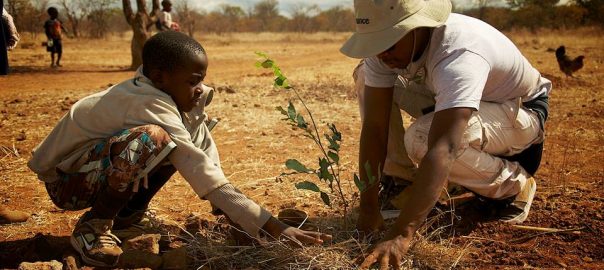
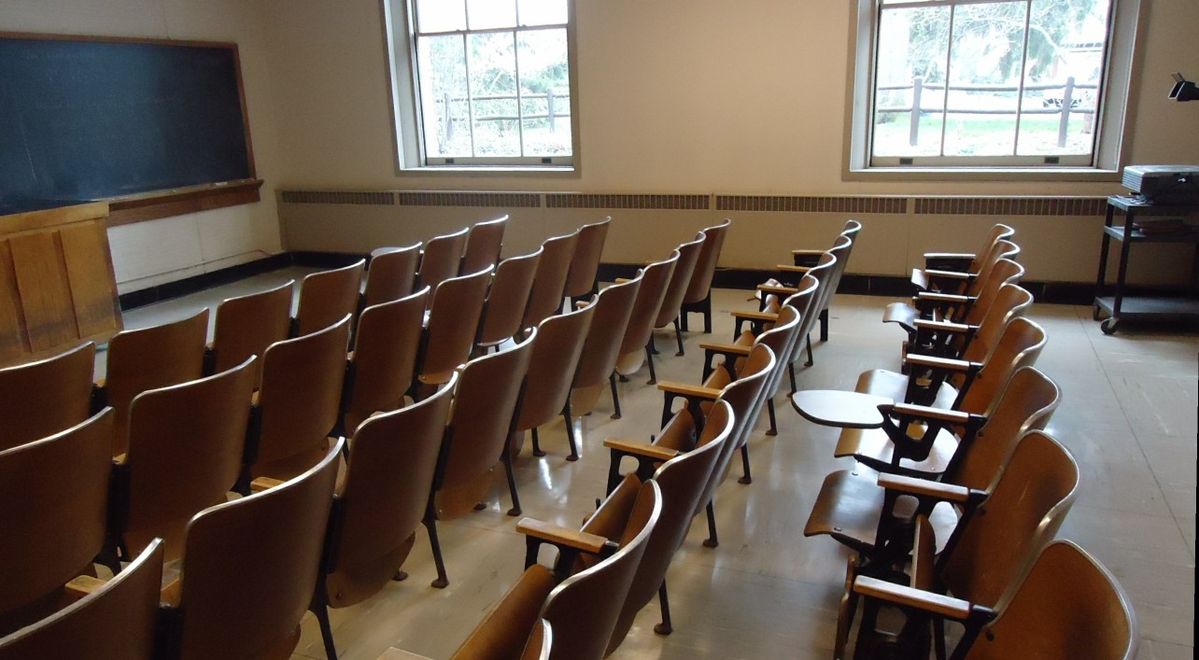

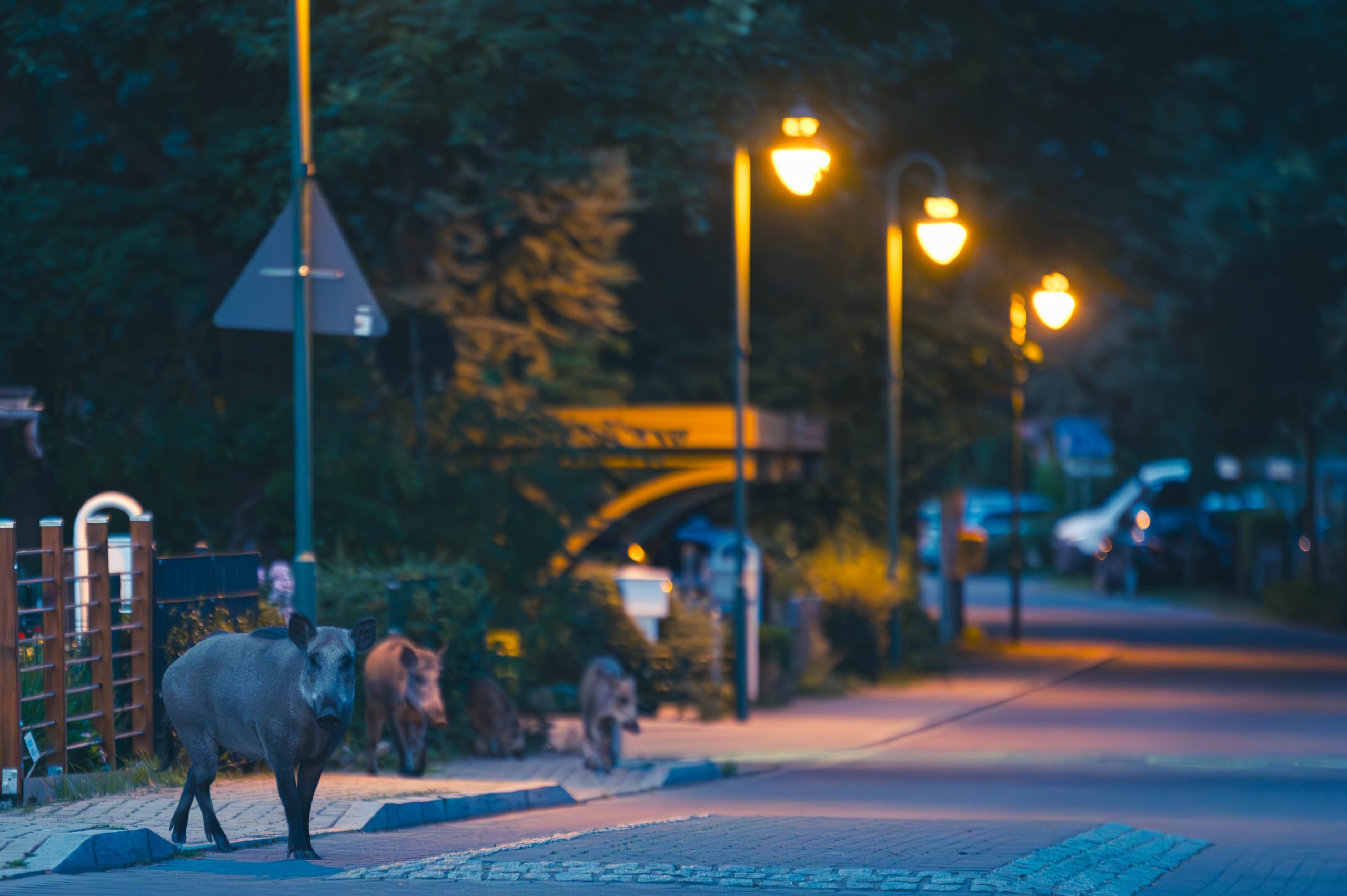
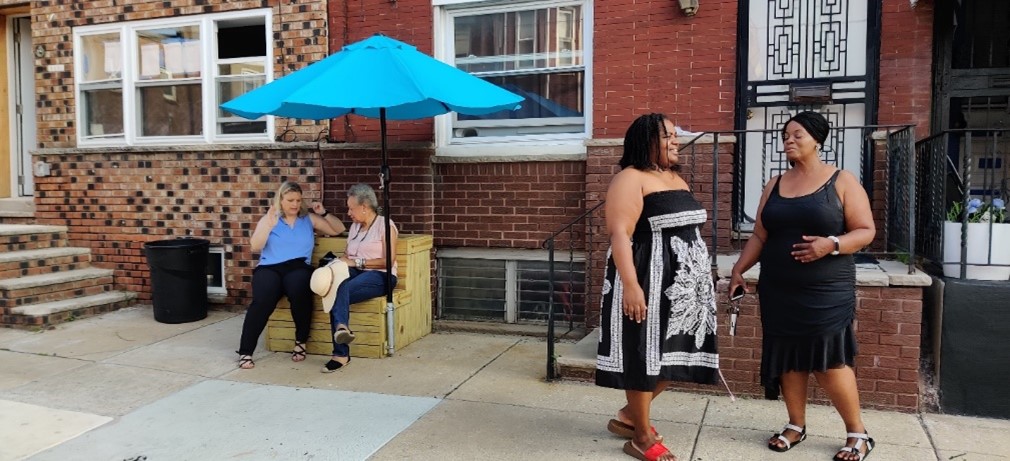
Leave a Reply